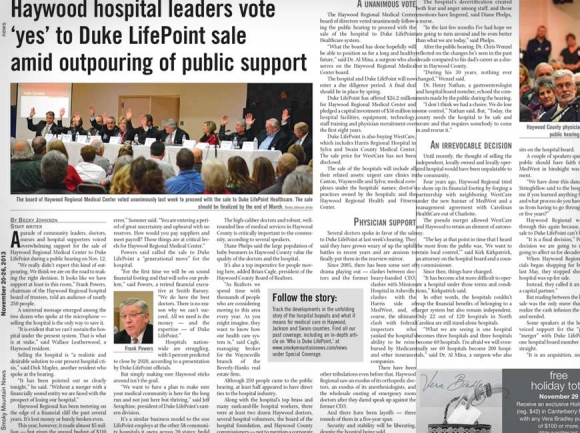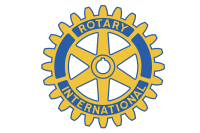2014: Transition to for-profit health care

Area hospitals finally found some steady financial footing in 2014 after years of floundering, trying to keep their heads above water as providing health care to rural Appalachia became more challenging.
Haywood Regional Medical Center and the community hospitals in Jackson and Swain counties — all nonprofit systems — were purchased by for-profit Duke LifePoint Healthcare, a joint venture of Duke University Health System and LifePoint Hospitals.
At the time, Asheville-based Mission Health had hoped Jackson and Swain hospitals — which were currently operating under the MedWest partnership along with Haywood Regional Medical Center — would have chosen to partner with its larger nonprofit health care system. The decision to become for-profit hospitals was disappointing for Mission leaders.
“At a time when so many are struggling to receive the care that they need, the incremental burden on residents and communities to not only pay for care but also ensure returns to shareholders on Wall Street and around the globe is troubling,” said Jon Yeatman, Mission’s vice president of strategic development, in 2013. “Regardless, Mission will continue to support the residents of these communities as we have for so many decades.”
While some people were hesitant about the change from a nonprofit to a for-profit model, others breathed a sigh of relief knowing these struggling hospitals would now get a much-needed influx of cash investment to get their facilities back on track and to meet the never-ending need for new medical technologies.
All three hospitals had been losing money prior to the Duke LifePoint purchase, which is why they formed the MedWest partnership in 2010.
Related Items
In 2008, Haywood Regional lost its Medicare and Medicaid status due to violations uncovered by health care inspectors and nearly closed its doors. Since 68 percent of the hospital’s revenue comes from Medicare and Medicaid reimbursements for patients, the hospital literally couldn’t afford to operate long without it. The hospital practically shut down for five months, which was a major blow to the staff and the community.
Dr. Henry Nathan said the crisis the hospital was facing was immense, one of the worst any hospital could encounter.
“It breaks our heart that this is happening,” Dr. Henry Nathan said in a 2008 interview. “I am concerned in the short term about people who count on their paycheck at the hospital. They will look for jobs elsewhere, and when the hospital gets their Medicare back it will be hard to find people to come back to work. It will be a setback to recuperate from this. The stigma also won’t be good for the long-term future of the county’s medical community.”
The thinking behind the MedWest Partnership was that Haywood, Jackson and Swain hospitals could merge their operations and save money, but the transition was rocky from the beginning. Some claimed the hospitals didn’t want to give up their autonomy to save money while others blamed cultural differences between the two medical staffs and an inability to change their competitiveness into a cooperative attitude.
Either way, it was obvious the partnership wasn’t working and another solution was needed. Jackson and Swain hospitals were the first to agree to the merger with Duke LifePoint in late 2013. Haywood Regional was officially sold to Duke LifePoint in August 2014.
Now under the Duke LifePoint umbrella with 65 other hospitals, Haywood, Harris and Swain seem to have recovered. All the facilities have expanded services, have new equipment and new capital projects to better meet the needs of rural Western North Carolina. It was an exciting time. The sale wiped out all the debt, loans and lines of credit that had been hovering over the hospitals’ heads for years.
LifePoint paid $26 million for Haywood Regional and $25 million for WestCare, which included Harris and Swain. Harris’ debt and outstanding bills ate up about two-thirds of the sale proceeds when all was said it done, but the medical community was more concerned with the for-profit’s commitment to invest in the aging hospitals.
Duke LifePoint promised $43 million in capital improvements at WestCare and $36 million for Haywood over the next eight years. Top priorities for Harris included a new emergency room and a complete remodel of the labor and delivery unit of the hospital. The hospital celebrated an $11 million emergency department expansion project in the fall of 2017, shortly followed by the opening of its $6 million New Generations Family Birthing Center in early 2018.
Since the sale, Haywood Regional has also seen a number of improvements made to its aging structure, including a new roof, new equipment, plumbing and electrical work and mattresses. Other investments include a half million dollar renovation to the hospital’s health and fitness center and expanding its behavioral health unit.
The sale of a nonprofit system to a for-profit system also meant that the former hospital foundations could no longer raise funds to support the hospital. The foundations had to dissolve or change their mission. The sale also meant a new nonprofit foundation would be formed to receive the proceeds from the sale to be used for the purpose of improving the health of residents.
Haywood County Commissioners had to decide in 2016 which organization would be tasked with managing an estimated $20 million left over from the HRMC sale — Asheville-based Community Foundation of Western North Carolina or the Haywood Healthcare Foundation. In the end, commissioners chose the Community Foundation because of its experience in managing these types of large endowments.
At the time of the Duke LifePoint purchase, Mission Health represented the last remaining nonprofit health system in the region. That’s no longer the case since Mission merged with HCA Healthcare in February of this year. Citing increased costs and stagnant reimbursements from Medicare, Medicaid and private insurance providers, Mission leaders said they had no choice but to join forces with a larger, for-profit system.









